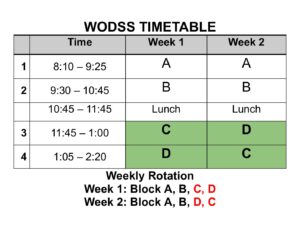August 30th, 2024
WODSS Cell Phone/Personal Device Policy – September 2024 Update
In November 2019, Ontario’s Ministry of Education implemented a policy that restricts cell phone use in schools to prevent distractions and maximize learning. (https://www.ontario.ca/page/cellphones-and-other-personal-mobile-devices-schools#section-1)
On April 28, 2024, the Ministry of Education further clarified the expectations for students’ use of phones while at school. (https://news.ontario.ca/en/release/1004501/ontario-cracking-down-on-cellphone-use-and-banning-vaping-in-schools)
As educators, we have a responsibility to cultivate an environment that encourages the learning and well-being of our students. Studies have shown that when students experience a sense of community, their achievement and well-being improve. Cell phones have positive uses, but in classrooms, they can lead to distracted, disengaged students who are socially isolated from their peers and their learning.
The following school policy is subject to change or revision in response to any future WRDSB policy.
As of September 4, 2024 WODSS requires that cell phones and wearable devices be in a bag/knapsack or locker and set to silent or turned off during instructional time.
Students may use their phone during the following times of the school day:
- before the first bell of the morning
- lunch time, until the first bell rings
- between classes
- after school
- designated spares
At no time should phones or any other recording devices be in the washrooms.
Staff will contact the office if students use cell phones outside of these expectations. These students will then bring their phone/device to the office, turn it off, label it with their name, and leave it in the office for the rest of the school day to support their regulation and attention. Devices cannot be picked up for lunch if they are stored in the office for the day unless the student is being signed out by a parent/guardian.
For Parents/Guardians/Caregivers
Parents/guardians and caregivers can reach their children at any time by calling the main office and we are more than happy to get them or deliver a message. Call 519-634-5441 or email WOD-attendance@wrdsb.ca with any relevant information. Students can also be reached via their WRDSB Gmail account.
Please refrain from texting or calling your student during class time or with difficult news during the school day that would be better shared in-person.
We recommend that you have a proactive conversation with your student about these new expectations before the school year begins. See “Steps You Can Take” below for some tips on how to have this conversation.
Exceptions
Students with documented medical conditions that require the use of a cell phone or wearable device (ie. diabetes, heart conditions, epilepsy, chronic respiratory diseases etc,).
To support special education needs, as documented in the student’s IEP.
Privacy Related to Digital Devices
Using cell phones or other digital devices to take video, photographs, audio or any other form of recording or documentation without the authorization or permission of the individuals involved including all staff, students or visitors is strictly prohibited.
Why Are We Refocusing Our Attention on this Issue?
What WODSS staff have observed:
Teachers and administrators at WODSS and in the WRDSB have reported over the last few years that the number one distraction for students is their cell phone. Cell phone use has a significant impact on students’ time on task, the time they spend out of the classroom, and also their overall academic achievement. Self-regulation is a key employability skill. Minimizing distractions for students, supporting their capacity for regulation and optimizing the conditions for learning is our key goal. Trying to get students to refocus away from cell phones and back to class work is one of the main sources of conflict between students and teachers. Cyber-bullying and negative social media and group chat interactions also lead to significantly increased numbers of suspensions and decreased well-being.
What the Research Tells Us
Impact on Academics:
Researchers at Wilkes University in Pennsylvania conducted a study of their students to determine the extent to which cell phones were used in classes there. Of those surveyed, 92% said they use their phones to text during classes and 10% admitted to having texted during an exam (Tindell and Bohlander, 2011). The majority of these students believed that their professors were unaware of these activities. While phones can be an effective tool for communication with peers and teachers when used properly, the majority of students are not using them for academic purposes; they are texting, snapping photos and using social media. These activities take away from the classroom experience, interfere with information retention and impact classroom management and student/teacher conflict (Froese, et al., 2012; Huey and Giguere, 2022; Tindell and Bohlander, 2011).
Melissa Huey, professor of Psychology at New York Technical University and her associate, David Giguere, professor of Psychology at California State University – Sacramento found in an experiment that students who did not access their phones during classes “had higher levels of course comprehension, lower levels of anxiety, and higher levels of mindfulness” – being aware and “present” during class (2022). In fact, use of phones in class is associated with lower academic performance as measured by GPAs. This has been confirmed by Arnold Froese and his colleagues at Sterling University, who experimented with students receiving or not receiving texts during a lecture. Their results showed a 27% lower success rate on the test provided afterward when students were texting during the lecture than when they were not texting (2012).
The evidence of the negative impact cell phone use has on student academic performance is overwhelming. If you would like to look at some of this research for yourself, please refer to the following research articles on the topic.
- The Use and Abuse of Cell Phones and Text Messaging in the Classroom: A Survey of College Students, by Deborah Tindell and Robert Bohlander (2011) (https://www.tandfonline.com/doi/full/10.1080/87567555.2011.604802?needAccess=true)
- Effects Of Classroom Cell Phone Use On Expected And Actual Learning, Froese, et al. (2012) (https://citeseerx.ist.psu.edu/document?repid=rep1&type=pdf&doi=747c5e20646a00b2b48f6303658788bd8a0e714f)
- The Impact of Smartphone Use on Course Comprehension and Psychological Well-Being in the College Classroom, Melissa Huey and David Giguere (2022) (https://www.ncbi.nlm.nih.gov/pmc/articles/PMC9676861/)
Impact on Mental Health:
Dr. Jean Twenge, professor of Social Psychology at San Diego State University, found that in 2011, the number of people with a smartphone exceeded the number of people without one; indeed, participation in social media went from being optional to necessary if teens wanted to fit in (2018). And yet, those who use social media frequently are more likely to feel left out, lonely, like they cannot do anything right and that they are not useful, says Dr. Nir Eyal, Consumer Psychologist with Stanford Graduate School of Business and the Hasso Plattner Institute of Design at Stanford University (Eyal, 2019; PBS, 2017). Because posts are polished, unrealistic versions of the best points in people’s lives and because teens now equate likes and followers with being liked and having friends, more time online with social media has been linked to lower self-esteem. In addition, cell phones and social media have displaced the time teens used to spend engaging in physical activity and engaging in face-to-face interactions, which are protective factors for mental health (Twenge, 2018; Eyal, 2019; Netflix, 2020; The Atlantic, 2020).
Multiple studies have shown a relationship between the increase in social media use in teens and young adults and an increase in mental health issues. Between 2011 and 2019 – a time of rapid increase in the presence and use of smartphones, rates of clinical depression in 12-17-year-olds doubled, as did rates of self-harm hospital admissions. In 10-14-year-old girls, the self-harm rate quadrupled and the suicide rate tripled during that same time frame. In 2016, the number of 12-17-year-olds diagnosed with a major depressive episode in the past year rose by 60% from the number just 5 years earlier (Twenge, 2018; Eyal, 2019; The Atlantic, 2020).
Steps You Can Take
There are meaningful next steps that can be taken. Experts at the Mayo Clinic suggest that there are some basic ways parents/caregivers can protect their teens from these impacts on their mental health (2022).
- Set reasonable limits: don’t let cellphone use interfere with sleep, meals and homework; avoid all screen use for 30-120 minutes before bedtime and keep devices out of bedrooms
- Monitor their accounts: make sure they know you’ll be keeping an eye on them, and know that even if a teen does not have an app on their phone (that you can see), that doesn’t mean they don’t have access to an app elsewhere
- Explain what’s not OK: discourage gossip, bullying, spreading rumours, or sharing any information with unknown or anonymous accounts
- Encourage face-to-face interactions: kids need to spend time with family and peers offline
- Talk about social media: share the unrealistic images you see and how it impacts you; ask about how their social media use makes them feel
If you wish to learn more about the connection between social media/cell phone use and mental health, or if you want more information on how to protect your teen, please refer to the following videos, books, articles and websites.
-
- Screen time and suicidal behaviours among U.S. children 9-11 years old: A prospective cohort study, National Library of Medicine (2023) (https://pubmed.ncbi.nlm.nih.gov/36805495/)
- Social Media and Youth Mental Health, The U.S. Surgeon General’s Advisory (2023) (https://www.hhs.gov/sites/default/files/sg-youth-mental-health-social-media-advisory.pdf)
-
- Teens and social media use: What’s the impact?, Mayo Clinic (2022) (https://www.mayoclinic.org/healthy-lifestyle/tween-and-teen-health/in-depth/teens-and-social-media-use/art-20474437)
- Canadians’ assessments of social media in their lives, Statistics Canada (2021) (https://www150.statcan.gc.ca/n1/pub/36-28-0001/2021003/article/00004-eng.htm)
- Frances Haugen’s Congressional Testimony, C-SPAN (2021) (https://www.youtube.com/watch?v=GOnpVQnv5Cw)
-
- The role of online social networking on deliberate self-harm and suicidality in adolescents: A systematized review of literature, National Library of Medicine (2018) (https://www.ncbi.nlm.nih.gov/pmc/articles/PMC6278213/)
- Increase in Depressive Symptoms, Suicide-Related Outcomes, and Suicide Rates Among U.S. Adolescents After 2010 and Links to Increased New Media Screen Time, Journal of Clinical Psychological Science (2017) (https://journals.sagepub.com/doi/abs/10.1177/2167702617723376?journalCode=cpxa)
- Too much screen time harms youth; how families and government can drive better outcomes, CBS News (2023) (https://www.cbsnews.com/colorado/news/too-much-screen-time-harms-youth-mental-health/)
- iGen: Why Today’s Super-Connected Kids Are Growing Up Less Rebellious, More Tolerant, Less Happy–And Completely Unprepared for Adulthood, Jean M. Twenge (2018)
- How Does Social Media Impact Gen Z’s Mental Health? (With Elyse Myers) | The Atlantic Festival 2022, The Atlantic (https://youtu.be/gUpEwpZgC5A)
- Are smartphones making a generation unhappy?, PBS News (2017) (https://youtu.be/MA8q88nEEwM)
- Smart Phones, Social Media and Stress: Featuring Jean Twenge (iGen) and Nir Eyal (Hooked), Helen and Arthur E. Johnson Depression Center, University of Colorado, (2019) (https://youtu.be/T6IBlFELDxc)
- ‘Put learners first’: UNESCO calls for global ban on smartphones in schools, The Guardian (2023) (https://www.theguardian.com/world/2023/jul/26/put-learners-first-unesco-calls-for-global-ban-on-smartphones-in-schools#:~:text=Unesco%2C%20the%20UN%27s%20education%2C%20science,effect%20on%20children%27s%20emotional%20stability.)
- The Social Dilemma, Netflix documentary (2020)

